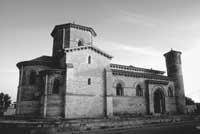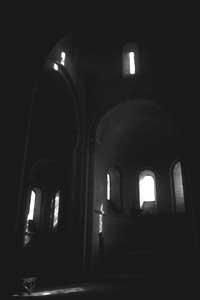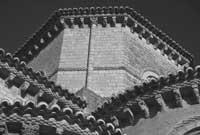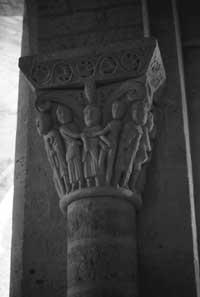Numology (and VI)

The study of numbers has not been carried out solely from the point of view of Mathematics throughout history. The religious and philosophical part has also led man to study numbers and their relationships. An example of this is Pythagoras: in his belief numbers were the basis of all things; another example is Kabala (Kabalah, Qabalah, Cabbala or Cabala): the Hebraitarras assigned a number to the letters and then calculated the numbers corresponding to each word and phrase to draw conclusions based on the result. Ideas that have emerged from the religious-philosophical point of view have survived all times of history.
In the Middle Ages, along with the official religion, one (or several) occult religion developed (or were). Initiates, templars, cabala, stonecutters, Finis Terrae, Camino de Santiago... All these words are witnesses of that secret religion. On the way to Finis Terrae, or to Santiago, or to the end of the earth, it is easy to find an important example of the religious and philosophical exploration of numbers. J. G. In “La Ruta Sagrada” in Atienza you can read what is on these lines about the numbers and their meaning found under the Romanesque church of San Martín de Fromista.

After this explanation, list behind the first twelve numbers relating them to the different parts of the building. Below is the meaning of these twelve numbers and their reflection in the building, of course, J. G. With the help of Atienza.
MAGNITUDE 12: It is not only presented in the scheme of the basic cosmic structure, but also in its union with unity, that is, as 13 or through its multiple forms. 52 capitals (13 x 4) offer a symbolic scheme of the hidden history of the world and of the concrete steps that man will have to take in the process towards Discovery through Death and subsequent Renaissance. Another 26 exterior capitals (13 x 2) are located next to the 13 windows, from which light penetrates the sacred area.
MAGNITUDE 11 He tells us cursed and sin. On the other hand, it is incomplete from the human (10) and cosmic (12) point of view. We found no number 11 in the church of San Martín.
10 figures: It is the number of the whole; according to the Cabal, the number of the divine flow, the sign of the IO-Isis and the first letter of the name of God in the sacred alphabet of the Hebrans. In St. Martin, 10 are the column sections of the inner sides of the temple, so the believer must move towards the light that enters through the windows of the apse. The number 10 points out the road, covered by lateral naves until reaching the coronation of the apse.

It is said that NUMBER 9 has been regarded as the figure of supreme knowledge leading to the immediacy of the whole (10). And later, the number 9 of St. Martin on the summits of the temple, 9 on the roofs, that is, 3 on the towers and lantern, 3 on the apses, 2 on the arms of the cross and 1 on the central nave. At this point, Atienza points out that the roofs, like Wisdom, cannot be seen complete below and can only be seen from another position in its entirety.
We can read that the NUMERO 8 is located on the sides of the lantern, on the eight capitals passing to the apses and on the bases that separate the naves of the temple. Among other meanings, the 8th is the verticality of the infinite (8 –) and the 8th indicates the four elements and their cosmic projection.

Number 7: It is the union of the square (terrestrial) and the triangle (mountain that rises towards the sky) and reaches the believer by the 7 windows of the apse. The letter ZAIN, seventh of the Hebrew alphabet, is the cabalistic symbol of Light and the representation of the human eye capable of receiving it. There are seven stages of Islamic happiness and seven internal and external levels of St. Martin. Inside are, for example, bases, pillars, capitals and basses, transversal arches, upper capitals, arches of vaults and dome of flashlight.
The book refers to the arithmetic properties of number 6 –1 + 2 + 3 = 1 x 2 x 3 = 6–, so mathematicians, theologians and occultists agreed that the magnitude was especially significant. Martinez de Pasqually called the sum of the concepts of Intention, Will and Words; Euklides the perfect number (equal to the sum of the divisors) and S. Ambrose was the symbol of perfect harmony; the cabalists believed it represented the sixth sefira, TIFERET, beauty. In the sacred books Beauty and harmony The days of creation are reflected in being 6. This confirms that there are 6 stages that the Concave must pass through to achieve the understanding of Divinity.

In the church of San Martín there are 6 pillars of the temple from the west door to the apse, confirming the idea of an initiatory path that must travel 6 stages to the Sacred Conception from sunset. The intention of this structure is supported by the particularity that the north and south doors, which are the exit doors of the Christian temples, are located in the second and third space of columns, respectively, when the follower is in such stadiums, in the monastic contexts the vote that, symbolizing the possibility of leaving the initiatory formation, will not be able to perform in the following.
The scheme of number 5 is the staff. The Pentagram is the symbol of man, but in the world of magic it can become the diabolical symbol of the Aker. In architecture it was the basic scheme of the numerous Christian temples of the early years of the Middle Ages. Moreover, according to the architect Moessel, it is a template in which the hidden projection of the Christian basilica is structured. The Fromistan staff appears in detail: the upper vertex at the boundary that separates the central apse from the dome and the lower one at the foot of the axis of the towers.
The NUMERO 4 is the most luminous in any building, that is, the 4 zones. As an expression of the mundane, the 4 usual elements, the four cardinal points, according to which the sacred structure is constructed with the apse on its eastern side.

NUMBER 3 is essentially cosmic and sacred, as it represents the fullness of the divine Trinity and the splendor of its existence. It also embodies the quintessence of three-dimensionality, on which man can rise from his conditions to reach the next evolutionary stage. The aspect it adopts, And, at the same time, is the Hebrew YOD, the letter 10 of the sacred alphabet and the Greek GAMMA, the GHIMEL, the 3rd sound of the kabbalistic succession. The double meaning, from the shadows of the language of the birds, testifies that God presents himself before Man as ONE and all (10) and TRINA: identifying an important mystery that can only be understood through initiation, but that is widely represented in all places, while identifying our way of understanding the Universe (three-dimensional), the Sense of sight, the past, the creator of the WISDOM, and the third gesture of the ETERNAL. In Fromistan, this trinity appears in the 3 windows of the central apse, in the 3 entrances of the temple, in the 3 naves, but above all in the conjunction of lantern and two towers, forming the 3 summits of the temple. But among them are the DUALITY —number 2— and the UNION, with its elements grouped or distributed: two equal, slender and feminine cylindrical towers, and an octagonal lantern, almost of its height, the solitary and principal nucleus of the building complex, the crown of the whole —KETER— and the essence of everything that this set of mathematics has of the sacred, whose obvious purpose is to make sense
There are the hidden meanings that can be found in a single building, in the church of San Martín de Fromista, an example that is not the only one for those who seek the hidden meaning of numbers. On the other hand, I recommend the book to those who want to make the Camino de Santiago, since it is appropriate to know another perspective of the road.
Written on the numbers of the Romanesque church of San Martín de Fromista“I invite anyone who is willing to look at the temple without enthusiasm and then to say that it is not the most balanced, robust, ethereal and comfortable building he has ever seen. It is not built to the exact and precise measure of man, of his schemes and hopes; in his own conception of the world, the German philosophers called Weltanschauung in a tight and sensible proportion and far from any structure that does not belong to the sense of cosm. However, I will explain: Saint Martin, beyond the historical-cultural conceptions of scholarship and aesthetic research, adapts to the existential schemes that any individual carries in his genes, which, by materializing in a tangible and tangible structure, have identified us with him and become part of our intuitive idea about the great schemes of ourselves, our immediate realities and the Universe. Thinking about the reasons that will allow this notoriety, I think the essence is the perfect balance that leads to the whole building. Balance based on the figure and perfectly dosed throughout the structure, turning the temple into a dodecalogue that does not see the visitors, but that detects that it enters the memory and that, without continuity solution, makes them happen to be part of the structure already identified. Look, if not, in its entirety. And we count and measure from behind for the first sources of the number, as in a new pilgrimage.” |





